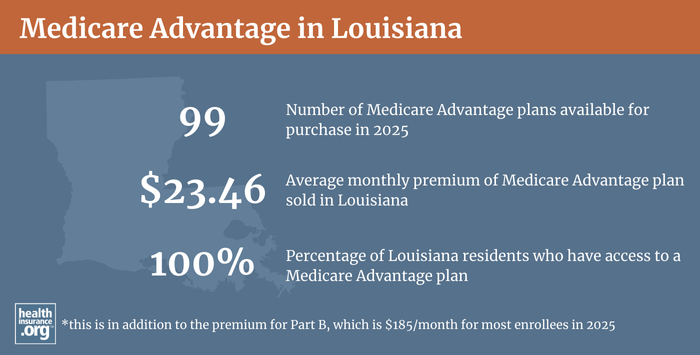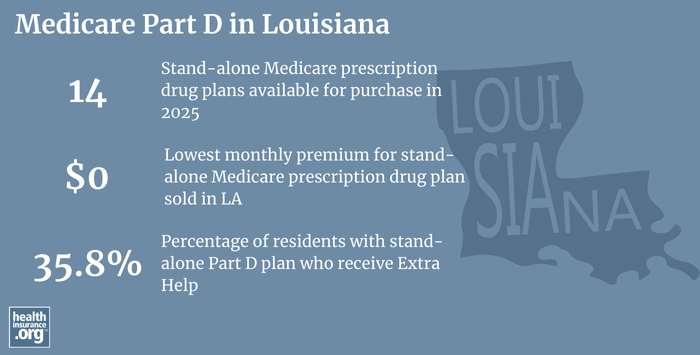Medicare in Louisiana

Louisiana now has a Medigap “birthday rule” that allows enrollees to switch to a plan (with the same insurer or an affiliate) that offers equal or lesser benefits
Key Takeaways
- More than 930,000 residents are enrolled in Medicare in Louisiana.1
- More than half of Louisiana Medicare beneficiaries are enrolled in Medicare Advantage plans.1
- 37 insurers offer Medigap plans in Louisiana.2
- There are 14 stand-alone Medicare Part D prescription plans available in Louisiana for 2025, with premiums that start at $0 per month.3
- Nearly 275,000 Louisiana Medicare beneficiaries have stand-alone Part D coverage, while about 500,000 have Part D integrated with a Medicare Advantage plan.1

Medicare enrollment in Louisiana
As of August 2024, there were 936,258 residents enrolled in Medicare in Louisiana.1 That was about 17% of the state’s population and roughly the same as the percentage of the total U.S. population with Medicare coverage enrollment.4
For most Americans, Medicare benefits come with turning 65. But Medicare eligibility is also triggered for younger people if they’re disabled and have been receiving disability benefits for 24 months, or are diagnosed with ALS or end-stage renal disease.
In Louisiana, more than 15% of Medicare beneficiaries are under the age of 65,1 versus a nationwide average of about 11%.5
Medicare options
When a person becomes eligible for Medicare, they can choose between Medicare Advantage plans, where coverage is through private health insurance companies, or Original Medicare, where medical claims are paid directly by the federal government. Original Medicare beneficiaries also have options around Medigap policies and Medicare Part D (prescription drug) coverage.
Original Medicare includes Part A (also called hospital insurance), which helps pay for inpatient stays at a hospital, skilled nursing facility, or hospice center, and Part B (also called medical insurance), which helps pay for outpatient care like physician services, kidney dialysis, outpatient surgeries, physical therapy, preventive health care, and durable medical equipment.
Medicare Advantage plans include all the coverage of Parts A and B, although cost-sharing amounts (deductible, coinsurance, copays) can be very different. Advantage plans usually include extra benefits, such as Part D prescription drug coverage and dental and vision coverage. But Advantage plans also tend to have limited provider networks and higher out-of-pocket costs than a person would have if they enrolled in Original Medicare plus a Medigap plan. There are pros and cons to either option, and the “right” solution is different for each individual.
Medicare’s annual election period (October 15 to December 7 each year) allows Medicare beneficiaries the chance to switch between Medicare Advantage enrollment and Original Medicare (and add, drop, or switch to a different Medicare Part D prescription plan). And beneficiaries who are already enrolled in Medicare Advantage plans also have the option to switch to a different Medicare Advantage plan or to change to Original Medicare during the Medicare Advantage open enrollment period, which runs from January 1 to March 31.
- Understand the difference between Medigap, Medicare Advantage, and Medicare Part D (including tips for picking the best coverage combination to meet your needs).
- Learn how Medicaid can provide assistance to Louisiana Medicare beneficiaries who have limited financial resources.
Learn about Medicare plan options in Louisiana by contacting a licensed agent.



Explore our other comprehensive guides to coverage in Louisiana

We’ve created this guide to help you understand the Louisiana health insurance options available to you and your family, and to help you select the coverage that will best fit your needs and budget.


Hoping to improve your smile? Dental insurance may be a smart addition to your health coverage. Our guide explores dental coverage options in Louisiana.


Learn about Louisiana’s Medicaid expansion, the state’s Medicaid enrollment and Medicaid eligibility.


Short-term health plans provide temporary health insurance for consumers who may find themselves without comprehensive coverage. Learn more about short-term plan availability in Louisiana.

Frequently asked questions about Medicare in Louisiana
What is Medicare Advantage?
Private Medicare Advantage plans are available throughout Louisiana. 100% of people with Medicare have access to a Medicare Advantage plan in 2025.6
34 percent of the state’s Medicare beneficiaries were enrolled in Medicare Advantage plans as of 2018, which was the same as the percentage of Medicare beneficiaries with Medicare Advantage plans nationwide. As of August 2024, private Medicare enrollment in Louisiana stood at 525,543 people, and 410,715 had Original Medicare.1

What are Medigap plans?
Original Medicare does not limit out-of-pocket costs (i.e., deductible and copay), so most enrollees maintain some form of supplemental coverage. More than half of Original Medicare beneficiaries get their supplemental coverage through an employer-sponsored plan or Medicaid.
But for those who don’t, Medigap plans (also known as Medicare supplement plans) will pay some or all of the out-of-pocket costs they would otherwise have to pay if they had only Original Medicare. According to an AHIP analysis, 153,792 Louisiana Medicare beneficiaries had supplemental coverage under Medigap plans as of 2021.
Medigap plans are sold by private insurers, but the plans are standardized under federal rules. There are ten different plan designs (differentiated by letters, A through N), and the benefits offered by a particular plan (Plan G, Plan N, etc.) are the same regardless of which insurer sells the plan.
There were 35 insurers that offered Medigap plans in Louisiana when the state published its most recent Medigap shopping guide in 2017. for 2025, Medicare’s plan finder tool showed 37 Medigap insurers offering plans in the state.2 Medigap insurers in the state are required to maintain minimum loss ratios of at least 65% for individual policies, and at least 75% for employer group policies. This means that at least 65% (or 75% for group plans) of the premium revenue that the insurers bring in must be spent on enrollees’ medical claims.
Unlike other private Medicare coverage (Medicare Advantage and Medicare Part D plans), there is no annual open enrollment window for Medigap plans. Instead, federal rules provide a one-time six-month window when Medigap coverage is guaranteed-issue. This window starts when a person is at least 65 and enrolled in Medicare Part B (you must be enrolled in both Part A and Part B to buy a Medigap plan).
And as of August 2022, Louisiana has a “birthday rule” that allows a Medigap enrollee a 63-day window, following their birthday, during which they can switch to another Medigap plan of equal or lesser benefits, offered by the same insurer they already have, with no medical underwriting. This is the result of legislation (HB294) that Louisiana enacted in 2022.
Louisiana joined several other states that already had birthday rules on their books. Most of those other states allow beneficiaries to use their birthday enrollment window to switch to another Medigap plan of equal or lesser benefits offered by any insurer, but Louisiana and Illinois limit this opportunity only to plans offered by the beneficiary’s current insurer. Legislation was enacted in 2023 in Louisiana that lightly expands this to allow people to also use the birthday rule window to switch to a plan offered by an affiliate of their current insurer (as opposed to only a plan offered by their current insurer).
People who aren’t yet 65 can enroll in Medicare if they’re disabled and have been receiving disability benefits for at least two years, and more than 16% of Louisiana Medicare beneficiaries are under age 65. Federal rules do not guarantee access to Medigap plans for people who are under 65, but the majority of the states have implemented rules to ensure that disabled Medicare beneficiaries have at least some access to Medigap plans. Louisiana is among them, although the state’s 2017 Medigap guide indicated that was a fairly recent development in the state.
In Louisiana, disabled Medicare beneficiaries under the age of 65 have the same six-month open enrollment period for Medigap plans as a person who becomes eligible for Medicare in Louisiana due to age. But premiums are dramatically higher for enrollees under the age of 65 (in most cases, several times higher: 2023 premiums for Medigap Plan A for a 65-year-old Louisiana male range from $85 to $294/month; for a 50-year-old male, they range from $279 to $1,000/month). People who are enrolled in Medicare prior to age 65 have another Medigap open enrollment period when they turn 65. At that point, they can switch to a plan with the lower premiums that apply to people who are aging into Medicare, rather than qualifying due to disability.
Disabled Medicare beneficiaries can opt for Medicare Advantage instead (this includes beneficiaries with kidney failure, who were generally unable to join Medicare Advantage plans prior to 2021). Medicare Advantage plans are otherwise available to anyone who is eligible for Medicare, and the premiums are not higher for those under 65. But Advantage plans have more limited provider networks than Original Medicare, and total out-of-pocket costs can be as high as $8,300 per year for in-network care in 2023, in addition to prescription drug costs.
Although the Affordable Care Act eliminated pre-existing condition exclusions in most of the private health insurance market, those rules don’t apply to Medigap plans. Medigap insurers can impose a pre-existing condition waiting period of up to six months if you didn’t have at least six months of continuous coverage prior to your enrollment. And if you apply for a Medigap plan after your initial enrollment window closes (assuming you aren’t eligible for one of the limited guaranteed-issue rights), the Medigap insurer can consider your medical history in determining whether to accept your application, and at what premium.
What is Medicare Part D?
Original Medicare does not provide coverage for outpatient prescription drugs. More than half of Original Medicare beneficiaries have supplemental coverage via an employer-sponsored plan (from a current or former employer or spouse’s employer), and these plans often include prescription coverage.
But Medicare beneficiaries who do not have drug coverage through an employer-sponsored plan need to obtain Medicare Part D in order to have coverage for prescriptions. It can be purchased as a stand-alone plan, or as part of a Medicare Advantage plan with integrated Part D prescription drug coverage. And beneficiaries who are dually-eligible for Medicaid also have prescription coverage via Part D.
There are 14 stand-alone Medicare Part D plans for sale in Louisiana for 2025, with premiums that start at $0/month.3
274,365 beneficiaries of Medicare in Louisiana — about a third of the state’s total Medicare population — had prescription coverage under stand-alone Medicare Part D plans as of August 2024.1 But a much larger population — 505,689 beneficiaries — had Medicare Part D coverage integrated with their Medicare Advantage plans.1 As Advantage enrollment has grown in Louisiana, enrollment in stand-alone Part D plans has dropped, since most Advantage plans have integrated Part D coverage.
Medicare Part D enrollment follows the same schedule as Medicare Advantage: Beneficiaries can pick a Medicare Part D plan when they’re first eligible for Medicare, and they can switch plans during the annual open enrollment period in the fall, from October 15 to December 7, with coverage that takes effect the following January.

How does Medicaid provide financial assistance to Medicare beneficiaries in Louisiana?
Many Medicare beneficiaries receive assistance through Medicaid with the cost of Medicare premiums, prescription drug expenses, and services not covered by Medicare – such as long-term care.
Our guide to financial assistance for Medicare enrollees in Louisiana includes overviews of these programs, including long-term care benefits, Medicare Savings Programs, and eligibility guidelines for assistance.
What additional resources are available for Medicare beneficiaries and their caregivers in Louisiana?
These resources provide free assistance and information about Medicare programs and availability in Louisiana:
- Contact the Louisiana Senior Health Insurance Information Program for help with Medicare enrollment in Louisiana or have questions about Medicare eligibility in Louisiana
- The state has also created a user-friendly stoplight-style quick guide to private Medicare options.
- The Medicare Rights Center website provides information geared to Medicare beneficiaries, caregivers, and professionals.
Louise Norris is an individual health insurance broker who has been writing about health insurance and health reform since 2006. She has written dozens of opinions and educational pieces about the Affordable Care Act for healthinsurance.org.
Footnotes
- “Medicare Monthly Enrollment – Louisiana.” Centers for Medicare & Medicaid Services Data. Accessed December, 2024. ⤶ ⤶ ⤶ ⤶ ⤶ ⤶ ⤶ ⤶
- “Explore your Medicare coverage options.” Medicare.gov. Accessed October, 2024. ⤶ ⤶
- ”Fact Sheet: Medicare Open Enrollment for 2025” (56) Centers for Medicare & Medicaid Services. Sep. 27, 2024 ⤶ ⤶
- U.S. Census Bureau Quick Facts: United States & Louisiana.” U.S. Census Bureau, July 2023. ⤶
- “Medicare Monthly Enrollment – US” Centers for Medicare & Medicaid Services Data, December2024. ⤶
- ”Fact Sheet: Medicare Open Enrollment for 2025” (53) Centers for Medicare & Medicaid Services. Sep. 27, 2024 ⤶

